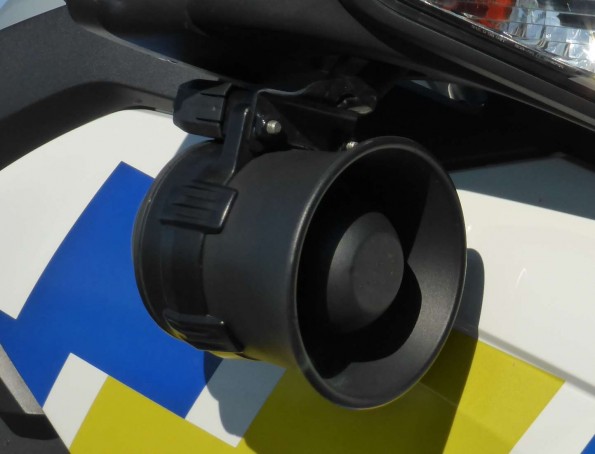The police (and other emergency services) use sirens as a warning to let motorists know they are coming.
Modern sirens oscillate (i.e. the pitch goes up and down), usually in a band that sits between 1-3kHz (this is the pitch of the siren), at a volume of around 100-110dB. Our ears are the most sensitive at around 2kHz, which means that less power is required to create the perception of a higher volume.
To give some perspective, 1kHz is just over an octave higher than middle A on a piano, and 3kHz is around 1.5 octaves higher than that. 110dB is the threshold of pain and is 16 times louder than a vacuum cleaner – check out some sound comparisons here. This is one of the reasons why a lot of motorbike traffic officers wear ear plugs (along with the fact that their bikes are loud, too); even the volume in police cars is loud with the windows up. Long term exposure to loud sounds causes hearing damage.
You can hear an example siren in the video below. It’s a dual siren – two oscillators.
The only problem with these types of sirens is that our ear finds it difficult to localise sounds in the 2-4kHz range, and we can only tell whether a sound is in front of us or behind us if it has components above 5kHz. Therefore the more frequencies and harmonics a siren contains, the easier it is to tell where the siren is coming from. But the more frequencies it contains, the more difficult it is for a siren to produce the volume.
How do we tell where a siren is coming from?
Our ears use four techniques:
- Interaural amplitude difference – the difference in volume between the two ears. The ear closest to the sound will hear it slightly louder.
- Interaural time difference – the difference in time between when the sound hits one ear to the other ear.
- Interaural phase difference – the phase of a waveform hitting one ear will be different to that of the other ear.
- Precedence effect or the Haas effect – the brain only uses the first sound for localisation and ignores any echoes which could cause confusion.
What can add to the confusion for motorists is that they are inside a metal and glass box when they hear a siren. The siren’s noise is transmitted through the glass and through any gaps in the bodywork at different phases and speeds and this can alter the perception of where the siren originates.
Problems with volume and type of sound
A loud siren will give people a lot of warning, but loud sirens can be damaging to people near to them, for example the officers in the car or on the bike.
The frequencies that a siren makes are somewhat blocked by soundproofing in cars, and also, as we found out above, it’s difficult to tell the direction they are coming from. One solution is to use an alternative ‘broadband’ sound with a lot of frequencies in. This is kind of a digital ‘horn’ that emergency response vehicles use at intersections.
Sirens are made in a specific way to produce a narrow band of sound very efficiently. This photo is of a siren on a BMW police motorbike in New Zealand.

